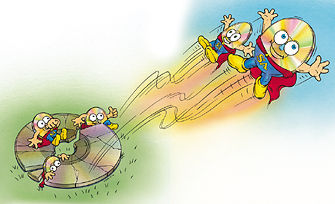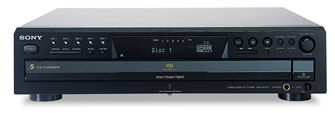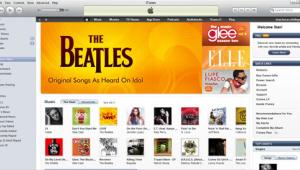The Bell Tolls for CD
You must allow me a bit of hyperbole for the sake of a powerful opening statement (which, as I assume they say in journalism school, is important). The truth is, the CD is about as dead as the analog television, which means it's alive and kicking just as it has always been. Still, the writing is on the wall for both formats. While the CD can at least take consolation in the fact that it doesn't have government mandates guaranteeing its demise, the future of audio has most definitely arrived (as with television) in the form of high-resolution. Let's not forget multichannel, either. While the hard-core music lovers are salivating over the potential of high-resolution, most are well aware that popular acceptance in America usually requires the new and different to be as big and flashy as possible. On many systems, the multichannel format is undoubtedly going to represent a more-noticeable change in the way people listen to music.

While the CD need not fear the government, it had better fear something a little closer to home: its own creators. Sony and Philips, who codeveloped the PCM-based, 16-bit/44.1-kilohertz CD format (aka the Red Book) that we know today, have jumped into the high-resolution, multichannel pool with a new Scarlet Book specification and the Super Audio Compact Disc (SACD). The SACD may resemble its forefather in appearance and may even do an impression of it on standard CD players, but the main differences lie in its aforementioned higher resolution—boasting a frequency response from 0 to 100 kilohertz and a dynamic range to 120 decibels—its multichannel-music playback, and its move away from the Pulse Code Modulation (PCM) system that was the foundation of the CD's success. Sony and Philips are directly or indirectly responsible for some 500 million players and 10 billion (that's billion) discs in circulation today; so, to be willing to move away from the CD and PCM, they must have some tricks up their collective sleeve that they feel fairly confident about.
As those player and disc statistics imply, the CD as we currently know it is undoubtedly the most popular digital format in the world—and you'll never hear me say it hasn't served us well. Nevertheless, it has become obvious, especially during the last few years, that digital audio is capable of much more. I think that, somewhere along the way, the general population made the mistake of assuming that, because CD is digital and because it's so popular, it is unquestionably the highest-quality consumer-audio source. There are lots of different reasons a format becomes popular (many of which have nothing to do with performance), and people have a natural tendency to assume that anything new is better—but better is a slippery word. Looking at the two main formats it replaced, the CD is better in certain respects. Compared with audio cassettes, most will agree that the CD is superior in just about every way. And, while most would agree that it's worlds more convenient and resistant to physical damage than vinyl, there are many who still feel that vinyl is sonically superior to CD. You can't argue about CD's increased bandwidth and dynamic range, but you can argue about the lost warmth—the presence and the timbre of the instruments and vocals that vinyl captures so well. Then there's CD's use of brick-wall filters, which noticeably affect the format's top end. In other words, everything in the audio signal that's 22.05 kHz and above (half of CD's 44.1-kHz sampling rate) is simply hacked off. Granted, most humans only hear into the 17- to 18-kHz range, but a great deal of research has been conducted that supports the theory that what we don't hear has a strong influence on what we do hear. It's the loss of the top end of CD's response that audiophiles and other trained ears have been complaining about all these years.

Entry-level SACD players like Sony's SCD-CE775 may not have video outputs, so they can't take advantage of many of SACD's peripheral features.
With the exception of HDCD, which unfortunately never seemed to catch on, the only innovations in consumer digital audio prior to SACD and DVD-Audio targeted issues of convenience and distribution (e.g., the MiniDisc and MP3) and took a step backward in terms of sound quality. The bottom line is that we're overdue for a digital-audio performance upgrade, and the CD is a venerable old technology whose time has passed. The DVD-Audio and Meridian Lossless Packing (MLP) camps know it; Sony and Philips know it, too. It isn't for lack of loyalty that they've turned away from their digital cash cow. It's the simple march of time and that ever-popular American battle cry for progress.
A Direct Digital Approach
Enter DSD, the ace up Sony's and Philips' sleeve. Direct Stream Digital coding is SACD—the two are inseparable. Even the low-resolution PCM track on an SACD (I'll get into that later) is a studio downconversion of the DSD track, and both high-resolution tracks (two-channel and six-channel) are straight DSD. The spark plug for DSD is Sony's and Philips' belief that, while PCM is good and represented the state of the art at the birth of the CD in 1980, substantial progress has been made throughout the digital chain (filtering, signal processing, conversion), in disc technology, and in identifying the sources of digital distortion (a subject that has led some to maintain their belief that vinyl and other analog sources are sonically superior to CD). Their take is that only small improvements can be made to PCM and that an entirely new approach is needed. Now, proponents of the PCM-based DVD-Audio technology (the competing high-resolution, multichannel music format that I discussed back in March) would obviously disagree—especially Meridian, creator of the MLP processing technology that's integral to DVD-Audio and operates only on PCM. However, as I did in the DVD-Audio piece, I will resist all but peripheral mentions of the "other" technology here and avoid direct comparison. That's a fray I'll jump into in part three of this series.

The high-end Philips SACD 1000 can utilize all of the audio and video perks that SACD has to offer.
In a nutshell, DSD utilizes 1-bit wordlengths with a sampling rate of 2.8224 megahertz (yes, that's very fast in the A/V world). Some simple math will tell you that this yields 2,822,400 bits per second per channel (versus CD's 705,600 bps)—and therein lies the high-resolution. Simply put, the point of using the 1-bit wordlength is to simplify the processes that all digital signals go through from recording to playback in order to minimize anomalies that materialize along the way.
- Log in or register to post comments
























































